- Previous chapters, and link, including National Centres by John Birch and the Research Study by Mike Fitzjohn & Malcolm Tungatt, have highlighted the role of the national Sports Councils including the amount of policy and technical advice that they published and was also provided by staff. This supplement records the roles of the Regional Offices and Regional Councils in the processes of advocacy, policy, advice and development in England. The circumstances in Wales, Scotland and Northern Ireland should be considered independently.
Genesis
-

Royal Charter
On 22nd December 1971, after its formative years, the draft of a Royal Charter was approved, “for constituting a Body Corporate under the name of ‘The Sports Council’”. This stated, “that there should be established an independent Sports Council with the objects of fostering the knowledge and practice of sport and physical recreation among the public at large and the provision of facilities therefor, building on the work in this field of the Central Council for Physical Recreation and others”.
- It proceeded to declare that, “In furtherance of its objects the Council shall have the following powers:-
- to develop and improve the knowledge and practice of sport and physical recreation in the interests of social welfare and the enjoyment of leisure among the public at large in Great Britain, and to encourage the attainment of high standards in conjunction with the governing bodies of sport and physical recreation;
- to foster, support or undertake provision of facilities for sport and physical recreation;
- to carry out itself, or to encourage and support other persons or bodies in carrying out, research and studies into matters concerning sport and physical recreation; and to disseminate advice and knowledge on these matters;
- to collaborate with foreign and international bodies in the furtherance of the foregoing or to secure the benefit of relevant experience abroad;
- to make grants and loans upon and subject to such conditions and otherwise as the Council shall deem fit in the furtherance of the foregoing ….;
- to carry on any other activity for the benefit of sport and physical recreation;
- to advise, co-operate with or assist Departments of Our Government, local authorities, the Scottish Sports Council, the Sports Council for Wales, and other bodies, on any matters concerned whether directly or indirectly with the foregoing;“
- We can see that facility provision, although it would not be the only function, was, following Wolfenden, a key issue from the start.
The Regional Context
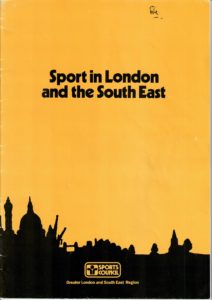 One way to begin to comprehend the full extent of the Sports Council’s ambitions, services and influence is to peruse the Council’s publications over the subsequent decades. It is an impressive volume and range of material. Yet this is just a partial view. For the full story it would be necessary to see the spread of regional publications from across the country. To do so is, simultaneously, a useful means of seeing the emergence and development of key themes and issues. Thus, for the more critical investigator, it is a survey of options, choices and directions; of familiar highways and lost byways; of questions answered and others not asked.
One way to begin to comprehend the full extent of the Sports Council’s ambitions, services and influence is to peruse the Council’s publications over the subsequent decades. It is an impressive volume and range of material. Yet this is just a partial view. For the full story it would be necessary to see the spread of regional publications from across the country. To do so is, simultaneously, a useful means of seeing the emergence and development of key themes and issues. Thus, for the more critical investigator, it is a survey of options, choices and directions; of familiar highways and lost byways; of questions answered and others not asked.- We could do the same in other contemporary aspects of leisure. Similar issues were challenging the Arts, Tourism, Countryside, Heritage, and more. They too had regional bodies promoting the objectives of national organisations. And it was the local authorities (LAs) especially after 1974, that were expected to provide or to enable provision. Some of them, as the SLLP shows, were leading the way.
- Local Government was crucial to all these ambitions, expected to ensure a full range of leisure and creating new types of civic buildings and public spaces as they did so. Corporately, LAs were subject to the attentions of the regional leisure agencies. De facto there was some competition for a local authority’s attention, accord and resources. These functions did not always fall within the remit of the Leisure Services Department. If they did those departments were not wholly staffed nor necessarily directed by sports people. There was no fee for Sports Council services nor Regional Council membership. Also, Sports Council regional offices encouraged the creation of Chief Leisure Officer Groups (CLOGs), typically on a County basis, and committed staff to support them as members of the Groups and in some cases providing the secretariat. As shown above, this was fulfilling founding principles and building on previous efforts (such as the promotion of Local/District Sports Councils). It was an infrastructure that served a generation until at least the creation of Government Regional Offices in the 1990s.
Regional Structures for Sport
- The Sports Council’s structure was summarised as: HQ, National Centres, Regional Offices. There was an alignment of Regional Offices and their Regional Councils with the country’s planning regions. Prior to local government reorganisation in 1974 the nine Regional Offices (and their representative Regionals Sports Councils) served:
SPORTS COUNCIL REGIONS Pre 1974
Northern: Co. Durham, Northumberland, North Riding of Yorkshire. (Based in Durham)
Yorkshire: East and West Ridings. (Based in Leeds)
East Midlands: Derbyshire, Leicestershire, Lincolnshire, Northamptonshire, Nottinghamshire, Rutland. (Based in Nottingham)
East: Bedfordshire, Cambridgeshire, Essex, Hertfordshire, Huntingdonshire, Norfolk, East and West Suffolk. (Based in Bedford)
Greater London & South East: Greater London, Kent, Surrey, East Sussex and West Sussex. (Based in London)
South: Berkshire, Buckinghamshire, Hampshire, Isle of Wight, Oxfordshire. (Based in Reading)
South-West: Somerset, Devon, Cornwall, Dorset, Wiltshire, Gloucestershire. (Based in Crewkerne)
West Midlands: Warwickshire, Staffordshire, Worcestershire, Shropshire, Herefordshire. (Based in Birmingham)
North West: Lancashire, Cheshire, Cumberland, Westmorland. (Based in Manchester)
-
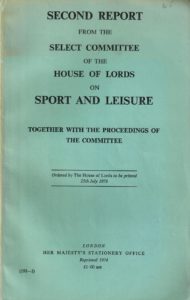
House of Lords Report
The 1974 reorganisation required some adjustment of titles and boundaries (see below) but was also an opportunity to assign strategic responsibilities to the regional sports councils. These new Regional Councils for Sport & Recreation (RCSRs) were established by Denis Howell in his White Paper, Sport and Recreation (HMSO, Cmnd. 6200, August 1975). This was informed not only by sporting concerns but by wider discussions and reports, such as those of the House of Lords Select Committee on Sport on And Leisure (HMSO, 1973). In section 36, the White Paper explains that:
“The Government have concluded that the time is now ripe for the establishment in England of a strong and unified regional machinery to consult and advise on needs and provision for sport and all forms of outdoor recreation on a region-wide basis. The successful experience of the last ten years with the Regional Sports Councils … leaves no doubt that this is the right model for the new organisation. In the Government’s view the new machinery should be independent of central government, should bring together representatives of local authorities and of a wide range of user and other affected interests, assisted by representatives of all the relevant government agencies and, more specifically, should be so structured as to be able to make a balanced regional assessment of the relationships and interactions of conservation and outdoor recreation in the countryside.”
- It continued (section 37) to stipulate that the Regional Sports Councils would be replaced by Regional Councils for Sport and Recreation who, “would be concerned with the whole range of sport and outdoor recreational activities in their regions” including, “a proper balance between formal and informal recreation, and between recreation and conservation, farming and forestry in the countryside”. It was envisaged they would advise the Countryside Commission as well as the Sports Council, including, “broad regional priorities for grant-aid in respect of regional facilities and services”. Also, “they would be specifically encouraged to promote the preparation of regional recreational strategies so as to provide an agreed framework within which recreational proposals in structure and local plans can be developed” (ibid).
- The White Paper (Sport and Recreation) gave more direction on “Principles of Policy”, specific topics and resources. Among resources it was concerned with the development of Recreation Management, with making better use of existing resources, with Joint Use and Joint Provision and with priorities such as Areas of Special Need, Young People, and Disabled People.
- Further direction on the new RCSRs was published in April 1976 (Regional Councils for Sport and Recreation, Department of the Environment, Circular 47/46). And Guidelines for Regional Recreational Strategies (Circular73/77) was issued by the Department of the Environment in July 1977. (It may be instructive to note that the Working Party on the Guidelines comprised nine members, all men: a mix of local authority and government department Planning Officers, the Sports Council and the Countryside Commission, and Messrs G. Bott and A. L .Winning from the leisure and recreation departments of Northampton Borough Council and Sheffield City Council respectively.)
- Thus, as their full title implies, these RCSRs were about much more than conventional sports. Their remit was not just the wider span of recreational activity but the greater interest and concern about society and leisure that was characteristic of the period. As their membership demonstrates, they covered not only the A-Z of Sport but Allotments as well as Athletics, Youth Hostels as well as Yachting.
- The RCSRs were not only to be a regional forum for the variety and large number of bodies, disciplines, personnel and opinions with interest and responsibility for sport and “physical recreation”. They also were charged to produce the policies, the Regional Recreation Strategies (RRSs), by which sport and recreation would be developed in each region, with respect to other interests. Another factor was the RCSRs were a mix of public and voluntary organisations, each with its own traits and of varied status. It was no small challenge to bring together so many diverse elements and to establish common ground and consensus.
- This is where the skills and personalities recruited into the RCSRs were important. RCSRS were staffed by the Sports Council but led by strong characters with successful backgrounds (in various fields) who shared an interest in Sport or Recreation. Some led from the front, spreading enthusiasm and engaging people (their Council members and around the region) in common purpose and into the regional networks. These people, the Chairs and their lieutenants, were champions for sport and the RCSRs gave them a platform. Peter Yarranton and Trevor Brooking were two RCSR chairs who went on to chair the Sports Council. Supporting the Chairs were senior figures who led Panels and working parties, presided over grant allocations and helped spread awareness through their own networks. The Chair and a Vice-Chair were appointed by the Minister who met them regularly to be briefed. The other Vice Chair was appointed by the local authorities.
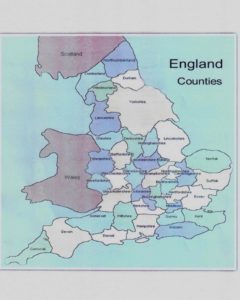 REGIONAL OFFICES and COUNCILS after 1974
REGIONAL OFFICES and COUNCILS after 1974
Northern Region: Northumberland, Cumbria, Durham, Cleveland and Tyne & Wear
North West Region: Lancashire, Cheshire, Greater Manchester and Merseyside
Yorkshire and Humberside Region: W Yorkshire, S Yorkshire, N Yorkshire and Humberside
Southern Region: Hampshire, Isle of Wight, Berkshire, Buckinghamshire and Oxfordshire
South Western Region: Avon, Cornwall, Devon, Dorset, Somerset, Wiltshire, and Gloucestershire
Eastern Region: Norfolk, Cambridgeshire, Suffolk, Bedfordshire, Hertfordshire and Essex.
Greater London and South East Region: Greater London, Surrey, Kent, East Sussex and West Sussex
East Midland Region: Derbyshire, Nottinghamshire, Lincolnshire, Leicestershire and Northamptonshire
West Midlands Region: West Midlands, Hereford & Worcester, Shropshire, Staffordshire and Warwickshire
[Note: Subsequently Greater London and South East divided into the two regions but shared a base at Crystal Palace NSC; later South East and South merged into an enlarged South East region. Also subsequently, Cumbria was re-allocated from the Northern to the North West Region]
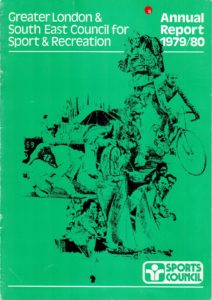 The Regional Offices and RCSRs operated in similar but not identical fashion. Self-evidently, one would expect, they reflected the nature of their region and the prevalence of particular characteristics and issues, for example: natural environment; extent of coast, inland water and wilderness; predominance of urban or rural areas; demographics; economies (including post-industrialism). New staff were recruited to serve emerging policy objectives. Consequently, the Sports Council drew on a variety of professional backgrounds; some, for example, were more attuned to the traditional structures of sports clubs and national governing bodies (NGBs) than the functions and processes of local government.
The Regional Offices and RCSRs operated in similar but not identical fashion. Self-evidently, one would expect, they reflected the nature of their region and the prevalence of particular characteristics and issues, for example: natural environment; extent of coast, inland water and wilderness; predominance of urban or rural areas; demographics; economies (including post-industrialism). New staff were recruited to serve emerging policy objectives. Consequently, the Sports Council drew on a variety of professional backgrounds; some, for example, were more attuned to the traditional structures of sports clubs and national governing bodies (NGBs) than the functions and processes of local government.- Originally, the Countryside Commission was to provide a joint secretariat with the Sports Council’s regional offices. This did not happen. The Commission had to serve an extensive remit of agricultural and conservation issues as well as recreation. There were obvious advantages to the Sports Council in promoting its objectives through the RCSRs but a scan of publications will show that the Sports Council, nationally and regionally, remained committed to a common agenda of coast, water and countryside recreation and to the needs of rural areas.
- As snapshots of RCSR interests here is the structure of the Greater London and South East Council (GLSECSR) and of Subject Reports produced in preparation and pursuit of its Regional Recreation Strategy (RRS), titled Prospect for the Eighties (1982).
GLSECSR STRUCTURE, 1982
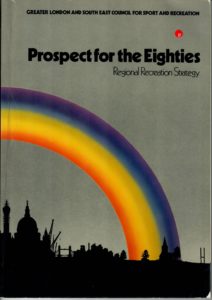 Chairman
Chairman
3 Vice Chairmen
Local Authority Members
User and Other Affected Interests
Advisory Panels:
-
-
-
-
- Facilities
- Grants
- Informal Recreation
- Participation
- Planning
- Water
-
-
-
GLSECSR RRS SUBJECT REPORTS
-
-
-
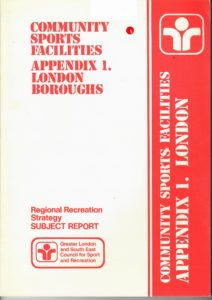 Issues Report (1979)
Issues Report (1979)- Marinas and Moorings part 1 (1977)
- Walking, Riding and Rights of Way (1980)
- Recreational Cycling (1980)
- Camping and Caravanning (1980)
- Marinas and Moorings part 2 (1981)
- Community Sports Facilities (1981):
- London Borough Summary
- County Summary
- Towards Greater Participation in Sport and Recreation (1981)
- Making Better Use of Resources (1981)
- Canals and Minor Rivers (1981)
- The After Use of Wet Mineral Workings (1981)
- Raising Standards of Performance
- The Pursuit of Excellence in Sport (1983)
- Recreation in the Metropolitan Green Belt (1984):
- Policy Statement
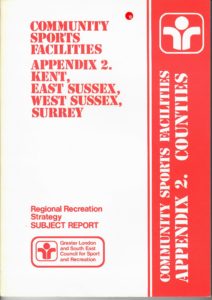 London’s Green Belt – A Handbook for Action (1983)
London’s Green Belt – A Handbook for Action (1983)- Rural Recreation in the South East (1988)
- Coastal Recreation in the South East (1989)
-
-
- Superficially, there is a similarity in the agendas and outputs of the Regional Councils, their committees, working parties and publications. Yet this was not repetition and duplication of national themes but the translation of national objectives into regional and local action, according to regional and local circumstances, as agreed by representative and specialist groups appointed by their regional peers.
- Incidentally, the extent and volume of regional advocacy, planning, funding and development (through contact, publications, policy, technical advice and engagement) sometimes led people to imagine the regional offices had more staff than was the case. Complements were more in the order of a couple of dozen people than of a local authority department. Although, of course, there was the larger resource of the whole Sports Council, its specialist units (such as TUS, Facilities and Research) and its national networks of specialists in fields such as Planning, Participation, Water & Countryside recreation, etc.
- The organisational structures and RRS subject reports prompt various lines of enquiry but, to pick out a few salient points:
Planning
-
First, the influence of Town & Country/Land Use Planning profession In the formative stages of this history (1960s and 1970s), the frameworks of enquiry and operation were in many respects led by Planning and associated professional and academic disciplines. It may be a surprise to read that ‘Planning’ was a matter of broad and long-term aspirations as well as detailed process; certainly beyond the short-term cycles of corporate plans and annual reports. Sports centres are a case in point: their development process – from identifying need to unveiling the plaque – was always a matter of years, not months. (This was to the detriment of the Council’s planning officers, whose achievements were often rooted years in the past or due to bear fruit years in the future.) From its inception, the Sports Council had recognised the need for – and provided – Planning expertise: for its holistic approach and comprehension; and because future progress would be promoted by statutory plans and negotiated through the statutory planning systems. Even local authority leisure centres were subject to the scrutiny and approval of planning applications.
- For example, it was the GLSECSR Planning Panel that led the Regional Recreation Strategy process. Its members included the County Planning Officers (CPOs) and the Greater London Council (GLC), the Sports Council’s head of planning (Mike Collins) and prominent academics such as Tony Veal.
- The RCSRs and their RRSs were expected to achieve the breadth of ambition explained earlier and to contribute to the statutory planning system. This continued through the succession of national and regional strategies from the Seventies to the end of the century. The planners in regional offices helped to support projects through the planning system. The Sports Council and RCSRS were consulted on planning matters by government departments, local authority planning departments, developers and other agencies. The Sports Council was a statutory consultee on applications relating to playing fields and defended them against hostile proposals. It was at Sports Council instigation that the Government published Planning Policy Guidance on Sport & Recreation. However, while ‘The Planners’ became a strong network within the Sports Council, the Planning profession, at least in some parts, became less involved in sport and recreation. It would appear that, professionally and structurally, the role of Planning had been superseded by the new Leisure Services Departments (including the production of District Sport & Recreation Strategies – and later, Cultural Strategies). Yet it also seemed that Planning lost its broader, visionary outlook and influence.
Innovation to Normalisation: Assessment and Redefinition
- Sport and leisure centres, then, were not the only nor even the primary concern of RCSRS and the regional SC offices. As the successive RRSs made clear, there was not a one-track approach to the development of Sport. However, the provision of centres was a key objective in future provision for communities; was a large element of the pre-Lottery capital programmes; and a feature of many a RCSR visit as it conducted its business around its region. The early strategies had focused on public need of Pools, Halls and Golf Courses plus Water recreation. Those early recommendations, reflecting limited resources and experience, had been sparse compared with what we accept – and expect – as normal today.
- In 1970, the GLSE Sports Council (further to the Sports Council’s 1969 report) described Pools, Halls and Golf Courses as ‘Major Sports Facilities’ – to distinguish them from the more ubiquitous but smaller and less costly playing fields, courts and club houses (GLSESC, Provision of Major Sports Facilities – An Assessment of Requirements Up To 1981, June 1970). It estimated 6 existing and a deficit of 140 ‘Indoor Sports Centres’: 3 existing and a deficit of 75 of in Greater London; only 1 existing and 10 required in Kent; only 1 existing and 16 required in the two counties of Sussex. Regional assessments were collated by the Sports Council to provide a national picture (The Sports Council, Provision for Sport, 1972). By 1980, there was clearer appreciation that these ‘Major Sports Facilities’ should be standard community provision. More “Community Sports Facilities” (Swimming Pools, Sports Halls and Artificial [later Synthetic] Turf Pitches [ATPs/STPs]) would need to be provided in order to serve people more locally, moving toward the pluralistic approach in the mid-Nineties explained in Chapter 4. There was also recognition of the specific needs of each sport (among which was more time for training) that led in time to a Specialist Facilities Strategy (English Sports Council, London and South East Regions, 1997).
Sport Development
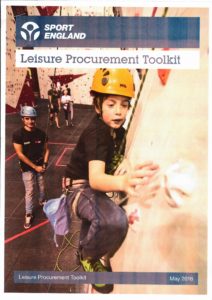 A third point, is that in these earlier periods ‘Facility’ issues – planning, design, funding, management and operations, etc – had been regarded as part of Sport Development. For example, taking a Sports Council Sport Development Bulletin at random (Sport Development Bulletin 29, Autumn 1974), the contents include: A national bowls headquarters; Two new golf courses; Pembroke Sports Centre; Growth of multi-sports clubs in Scotland; Recent leisure studies; RYA’s yacht racing centre; and Experimental sports pitches.
A third point, is that in these earlier periods ‘Facility’ issues – planning, design, funding, management and operations, etc – had been regarded as part of Sport Development. For example, taking a Sports Council Sport Development Bulletin at random (Sport Development Bulletin 29, Autumn 1974), the contents include: A national bowls headquarters; Two new golf courses; Pembroke Sports Centre; Growth of multi-sports clubs in Scotland; Recent leisure studies; RYA’s yacht racing centre; and Experimental sports pitches.- What occurred in subsequent decades, perhaps unintentionally promoted by regional strategies, was the bifurcation of ‘Management’ and ‘Development’; in effect, a distinction between facility provision and direct intervention. Sport Development became the title for the latter. To an extent the division was mitigated by both recreation management and sports development expanding within the structure of the new local authority comprehensive leisure service departments. Of course, ‘Recreation Management’ had the heft and kudos of capital investment in major civic projects; of fixed and tangible presence.
- During this critical period (ca. 1987- 1997) integrated approaches to Sport were subjected to the political demands of Compulsory Competitive Tendering (CCT). (In years to come by the whole philosophy of outsourcing, PFI and reduction of the public sector.) Arguably, a comprehensive approach was also affected by the way in which Recreation Management was professionalised and Sport was dividing into its own specialisms (including Academia). The history of these developments is local as well as national and, thus, so were the variety and timescales of local practice. Yet, to risk a generalisation, were centre staff and management sufficiently informed and engaged in the emergent awareness and priority of ‘Sport Development’ issues? As this Project progresses we may have a clearer view of the extent to which the bodies (including Trusts) operating public sport and leisure facilities in this century have integrated ‘Sport Development’ into their ethos and operations.
An end to an era?
- Well, that is what the Sports Council’s Annual Report 95/96 suggests. The then Chairman, Sir Rodney Walker, writes about the need for change, referring to changing policies between 1972 and 1993 and of changes occurring elsewhere:
“The delivery of sport to the individual has depended on working in partnership with local authorities, voluntary organisations, schools and other agencies. Many of these bodies have themselves had to adapt to the challenges of significant changeover the same period. Local government reorganisation, compulsory competitive tendering and the local management of schools have all impacted on the organisation and development of sport in one way or another. Constraints on Government expenditure have combined to add pressure on all those involved ….” [Chairman’s Foreword, pages 2 & 3]
- The abolition of the RCSRs by the Conservative Government in 1996 was one element in this period of changing circumstances and structures. The [GB] Sports Council itself was about to be restructured out of existence and a new English Sports Council (later Sport England) created. Prime Minister John Major had given Government priority to Sport in ‘Raising The Game’ (1995). A year previously, new legislation had created the National Lottery. Less sensationally, a burst of policy had been spreading in the first half of the decade based on Sport Development and Sport Equity principles. Further change and modernising tendencies were afoot.
 The RCSRs departed just as the pot of gold (i.e., the National Lottery) was generating new funds, new strategy, fresh ambitions and a new wave of facility provision (notably at schools). A new Labour Government (1997) set new imperatives. The seeds were being sown for the Golden Era of British Sport. By the early years of the new millennium the infrastructure of LA Leisure Service Departments and CLOGs was being succeeded by that of County Sports Partnerships and School Sport Partnerships. And, underlying all this, was the natural subversion of demographic shifts, of gender as well as generations.
The RCSRs departed just as the pot of gold (i.e., the National Lottery) was generating new funds, new strategy, fresh ambitions and a new wave of facility provision (notably at schools). A new Labour Government (1997) set new imperatives. The seeds were being sown for the Golden Era of British Sport. By the early years of the new millennium the infrastructure of LA Leisure Service Departments and CLOGs was being succeeded by that of County Sports Partnerships and School Sport Partnerships. And, underlying all this, was the natural subversion of demographic shifts, of gender as well as generations.- Whether the Regional Councils, in an evolved state, would still have been useful this century we never had chance to discover. They were extinguished by the latest in a sequence of Sports Ministers who were rarely in post long enough to get a holistic grasp of a vast and varied subject nor to appreciate how much planning and development occurred through these regional networks. (There was a similar impulsive purge after the General Election of 2010 when the systematic approach to Physical Education and School Sport – including its role in the wider community, sports centres included – was abruptly destroyed by Michael Gove.)
- There were replacements. Immediately, in 1996, similar if reduced ‘successor organisations’ (such as South East Sport) were created in all ten regions , which maintained some continuity. Subsequently there were pared-down Regional Sports Boards that, for all the good intentions of the people involved, were never as grass-rooted nor as connected to the Sport England offices as the RCSRs had been. Within a few years local authority leisure departments and council committees (and Chief Leisure Officer Groups) had been restructured out of their professional departments – with consequent loss of champions for sport. Sport England, as it now was, to become ‘more strategic’, withdrew to the point of invisibility from the regions (although accessible digitally, of course).
- The Sports Council, corporately, did not show much regret, RCSRs seemingly regarded at HQ as an independent anomaly within its own structures, tempting its regional staff to ‘go native’ and see issues from a local instead of a corporate perspective. It was quite relaxed at losing, collectively, its national network. There will be a case for such centralising tendencies. Yet it is not hindsight nor nostalgia that suggests there was a structured national process of investigation, education, understanding, ownership, authority, accountability, scrutiny and action before such notions, along with engagement and partnership, were jargonised with loose abandon in the managerial cultures of the new millennium. In practice, it was achieved by experience, intuition and personality. An inherent advantage was that Sport is inclined to be sociable.
- The successive generations who have had the benefit of an academic introduction to Sport will recognise that the structures created to establish sport can be analysed and described ideologically and in terms of organisational theory with reference to policy communities, advocacy coalition framework, multiple streams framework, policy brokers and so on. We could see such concepts in action in the regional development of sport and recreation. But now?
New times, old issues?
- It would be ridiculous to argue that the loss of RCSRs inhibited the provision of sport and leisure facilities. They would not have had the capacity to deal with the volume of bids to the Sport England Lottery Fund. Sports Centres and Swimming Pools continued to spread across the country, confounding earlier standards and models of provision.
- It does seem more reasonable to give the Regional Councils some credit for the earlier promotion and normalisation of Sport and Leisure Centres – and for the new profession and local authority services that provided and operated them. Alternatively, we could consider how things might have developed if Regional Councils had prioritised other forms of activity and intervention to produce a healthier nation.
- RCSRS were so closely associated with the Sports Council through the relationships with its regional offices and access to Sports Council resources that it was common for people to continue to refer to “regional sports councils”. Servicing the RCSRs was only one of the Sports Council’s functions but, in return, in terms of governance, the Councils conferred extra authority, legitimacy, transparency and accountability to the Sports Council within the regions it served and with the organisations it worked with. Working together they sustained a period of common purpose, action and innovation across the country through three decades.
- The RCSRs are already two decades away, fading from the history of Sport in England, dismissed by those who were not interested and unknown to the next generation. Yet there was a need for such bodies and development networks forty years ago. There are still acute – and often familiar – issues. Who is studying, lobbying and acting to deal with them? How is Sport and Recreation represented now? Is it adequate? Is it effective?
- The Regional Councils and networks described here originated from a period in which local authorities were still afforded the respect, responsibility and resources to look after their local communities. Looking back, the demise of the regional systems at the end of the century is probably less a surprise than their survival and achievements through the Eighties and Nineties. Policy brokers like Denis Howell caught the moment.
Jack Wilkinson October 2019

